Developing Literacy: Analysis of Narrative Writing Techniques
VerifiedAdded on 2021/06/14
|7
|2075
|175
Homework Assignment
AI Summary
This assignment analyzes the elements of narrative writing and its role in literacy development. The student's work explores various aspects of narrative writing, including pacing, sequencing of events, grammar, and communication skills. The analysis identifies strengths and weaknesses in the writing, such as the need for regulated pacing, proofreading, and improved story structure. The assignment emphasizes the importance of clear communication, proper grammar, and the use of descriptive language. It also suggests the use of cooperative learning and information communication technology to enhance writing skills. The student's work also discusses the benefits of sequencing and narrative flow, highlighting how they contribute to a reader's comprehension and retention of information. The assignment offers practical strategies and techniques to improve narrative writing, making it a valuable resource for students aiming to enhance their literacy and storytelling abilities.
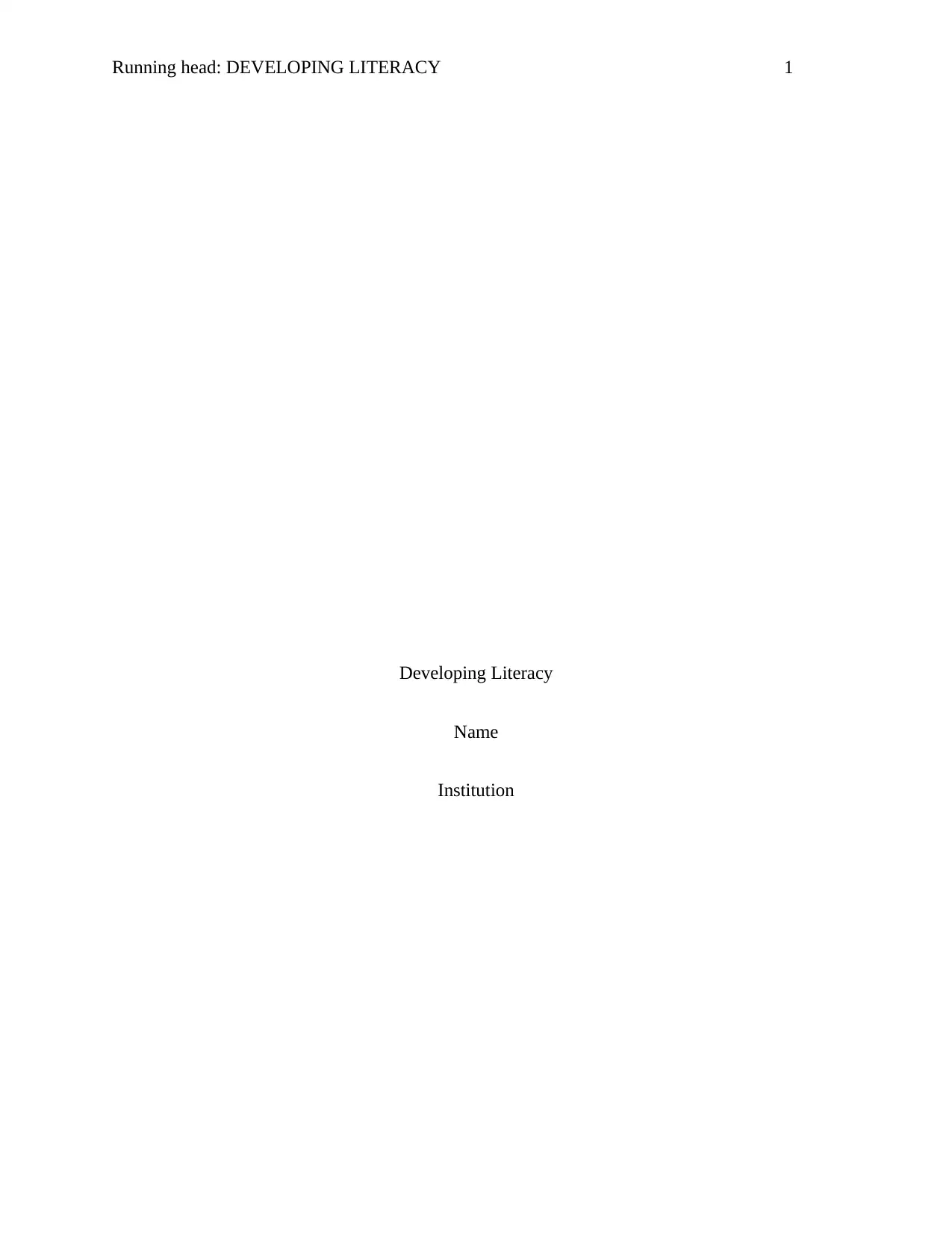
Running head: DEVELOPING LITERACY 1
Developing Literacy
Name
Institution
Developing Literacy
Name
Institution
Paraphrase This Document
Need a fresh take? Get an instant paraphrase of this document with our AI Paraphraser
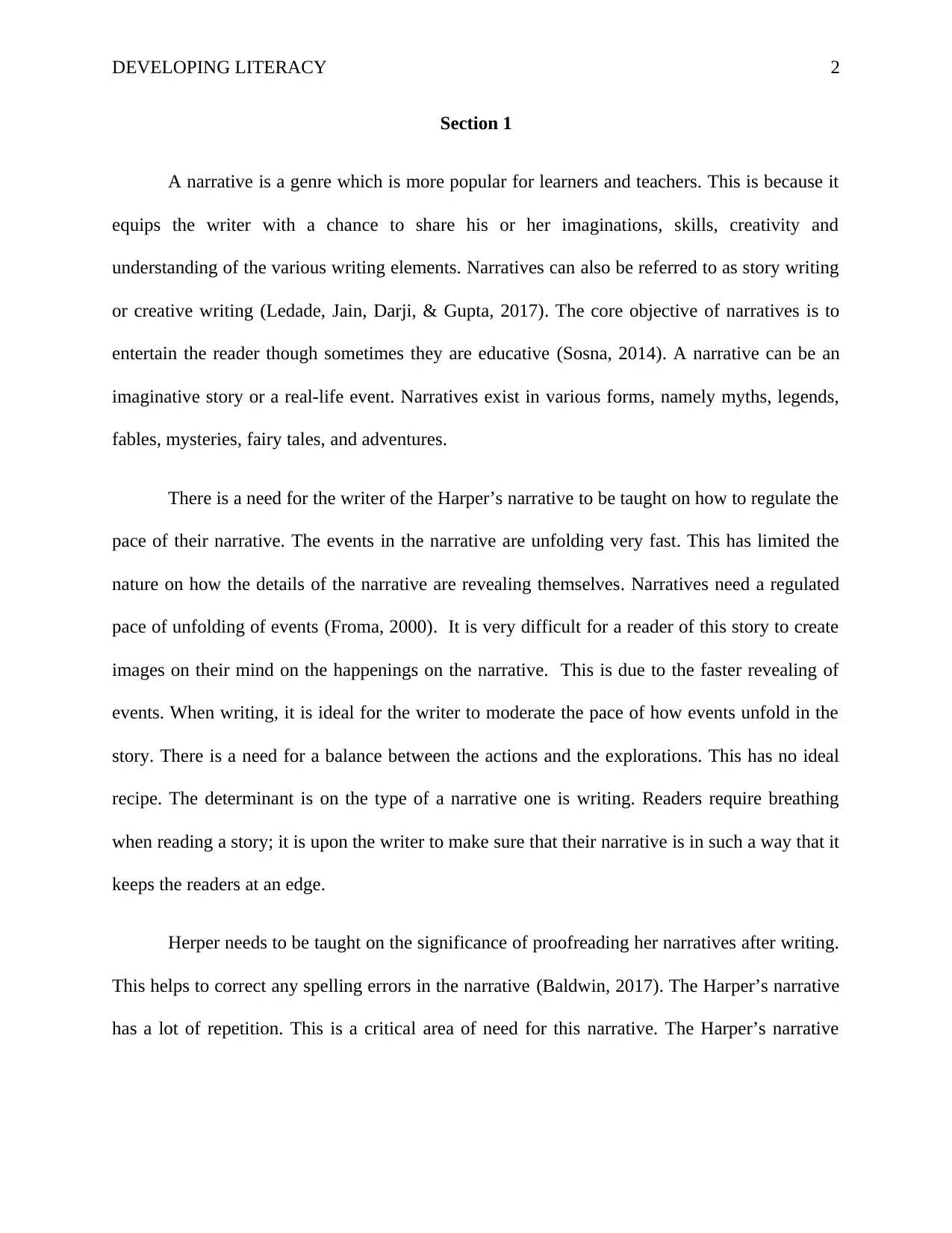
DEVELOPING LITERACY 2
Section 1
A narrative is a genre which is more popular for learners and teachers. This is because it
equips the writer with a chance to share his or her imaginations, skills, creativity and
understanding of the various writing elements. Narratives can also be referred to as story writing
or creative writing (Ledade, Jain, Darji, & Gupta, 2017). The core objective of narratives is to
entertain the reader though sometimes they are educative (Sosna, 2014). A narrative can be an
imaginative story or a real-life event. Narratives exist in various forms, namely myths, legends,
fables, mysteries, fairy tales, and adventures.
There is a need for the writer of the Harper’s narrative to be taught on how to regulate the
pace of their narrative. The events in the narrative are unfolding very fast. This has limited the
nature on how the details of the narrative are revealing themselves. Narratives need a regulated
pace of unfolding of events (Froma, 2000). It is very difficult for a reader of this story to create
images on their mind on the happenings on the narrative. This is due to the faster revealing of
events. When writing, it is ideal for the writer to moderate the pace of how events unfold in the
story. There is a need for a balance between the actions and the explorations. This has no ideal
recipe. The determinant is on the type of a narrative one is writing. Readers require breathing
when reading a story; it is upon the writer to make sure that their narrative is in such a way that it
keeps the readers at an edge.
Herper needs to be taught on the significance of proofreading her narratives after writing.
This helps to correct any spelling errors in the narrative (Baldwin, 2017). The Harper’s narrative
has a lot of repetition. This is a critical area of need for this narrative. The Harper’s narrative
Section 1
A narrative is a genre which is more popular for learners and teachers. This is because it
equips the writer with a chance to share his or her imaginations, skills, creativity and
understanding of the various writing elements. Narratives can also be referred to as story writing
or creative writing (Ledade, Jain, Darji, & Gupta, 2017). The core objective of narratives is to
entertain the reader though sometimes they are educative (Sosna, 2014). A narrative can be an
imaginative story or a real-life event. Narratives exist in various forms, namely myths, legends,
fables, mysteries, fairy tales, and adventures.
There is a need for the writer of the Harper’s narrative to be taught on how to regulate the
pace of their narrative. The events in the narrative are unfolding very fast. This has limited the
nature on how the details of the narrative are revealing themselves. Narratives need a regulated
pace of unfolding of events (Froma, 2000). It is very difficult for a reader of this story to create
images on their mind on the happenings on the narrative. This is due to the faster revealing of
events. When writing, it is ideal for the writer to moderate the pace of how events unfold in the
story. There is a need for a balance between the actions and the explorations. This has no ideal
recipe. The determinant is on the type of a narrative one is writing. Readers require breathing
when reading a story; it is upon the writer to make sure that their narrative is in such a way that it
keeps the readers at an edge.
Herper needs to be taught on the significance of proofreading her narratives after writing.
This helps to correct any spelling errors in the narrative (Baldwin, 2017). The Harper’s narrative
has a lot of repetition. This is a critical area of need for this narrative. The Harper’s narrative
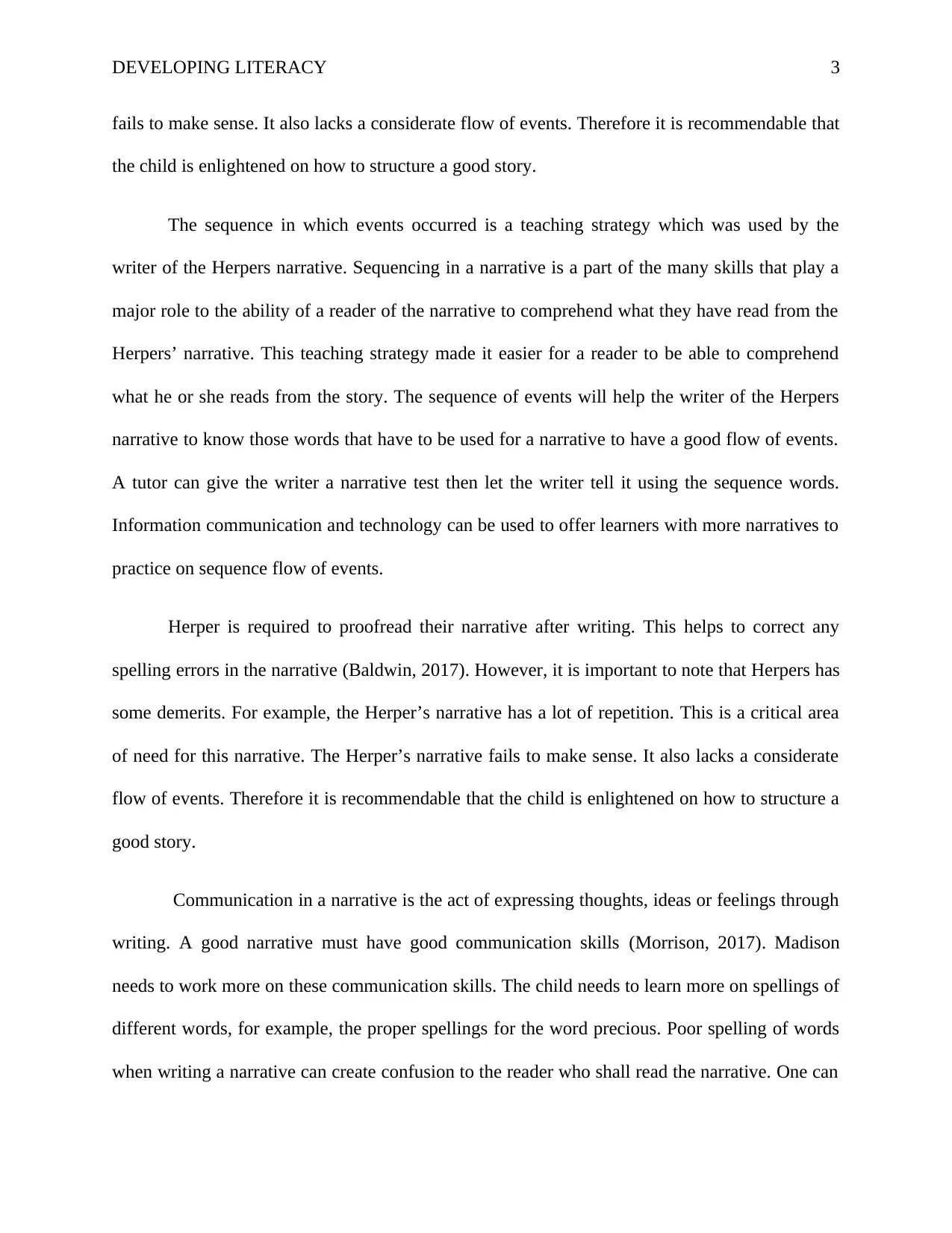
DEVELOPING LITERACY 3
fails to make sense. It also lacks a considerate flow of events. Therefore it is recommendable that
the child is enlightened on how to structure a good story.
The sequence in which events occurred is a teaching strategy which was used by the
writer of the Herpers narrative. Sequencing in a narrative is a part of the many skills that play a
major role to the ability of a reader of the narrative to comprehend what they have read from the
Herpers’ narrative. This teaching strategy made it easier for a reader to be able to comprehend
what he or she reads from the story. The sequence of events will help the writer of the Herpers
narrative to know those words that have to be used for a narrative to have a good flow of events.
A tutor can give the writer a narrative test then let the writer tell it using the sequence words.
Information communication and technology can be used to offer learners with more narratives to
practice on sequence flow of events.
Herper is required to proofread their narrative after writing. This helps to correct any
spelling errors in the narrative (Baldwin, 2017). However, it is important to note that Herpers has
some demerits. For example, the Herper’s narrative has a lot of repetition. This is a critical area
of need for this narrative. The Herper’s narrative fails to make sense. It also lacks a considerate
flow of events. Therefore it is recommendable that the child is enlightened on how to structure a
good story.
Communication in a narrative is the act of expressing thoughts, ideas or feelings through
writing. A good narrative must have good communication skills (Morrison, 2017). Madison
needs to work more on these communication skills. The child needs to learn more on spellings of
different words, for example, the proper spellings for the word precious. Poor spelling of words
when writing a narrative can create confusion to the reader who shall read the narrative. One can
fails to make sense. It also lacks a considerate flow of events. Therefore it is recommendable that
the child is enlightened on how to structure a good story.
The sequence in which events occurred is a teaching strategy which was used by the
writer of the Herpers narrative. Sequencing in a narrative is a part of the many skills that play a
major role to the ability of a reader of the narrative to comprehend what they have read from the
Herpers’ narrative. This teaching strategy made it easier for a reader to be able to comprehend
what he or she reads from the story. The sequence of events will help the writer of the Herpers
narrative to know those words that have to be used for a narrative to have a good flow of events.
A tutor can give the writer a narrative test then let the writer tell it using the sequence words.
Information communication and technology can be used to offer learners with more narratives to
practice on sequence flow of events.
Herper is required to proofread their narrative after writing. This helps to correct any
spelling errors in the narrative (Baldwin, 2017). However, it is important to note that Herpers has
some demerits. For example, the Herper’s narrative has a lot of repetition. This is a critical area
of need for this narrative. The Herper’s narrative fails to make sense. It also lacks a considerate
flow of events. Therefore it is recommendable that the child is enlightened on how to structure a
good story.
Communication in a narrative is the act of expressing thoughts, ideas or feelings through
writing. A good narrative must have good communication skills (Morrison, 2017). Madison
needs to work more on these communication skills. The child needs to learn more on spellings of
different words, for example, the proper spellings for the word precious. Poor spelling of words
when writing a narrative can create confusion to the reader who shall read the narrative. One can
⊘ This is a preview!⊘
Do you want full access?
Subscribe today to unlock all pages.

Trusted by 1+ million students worldwide
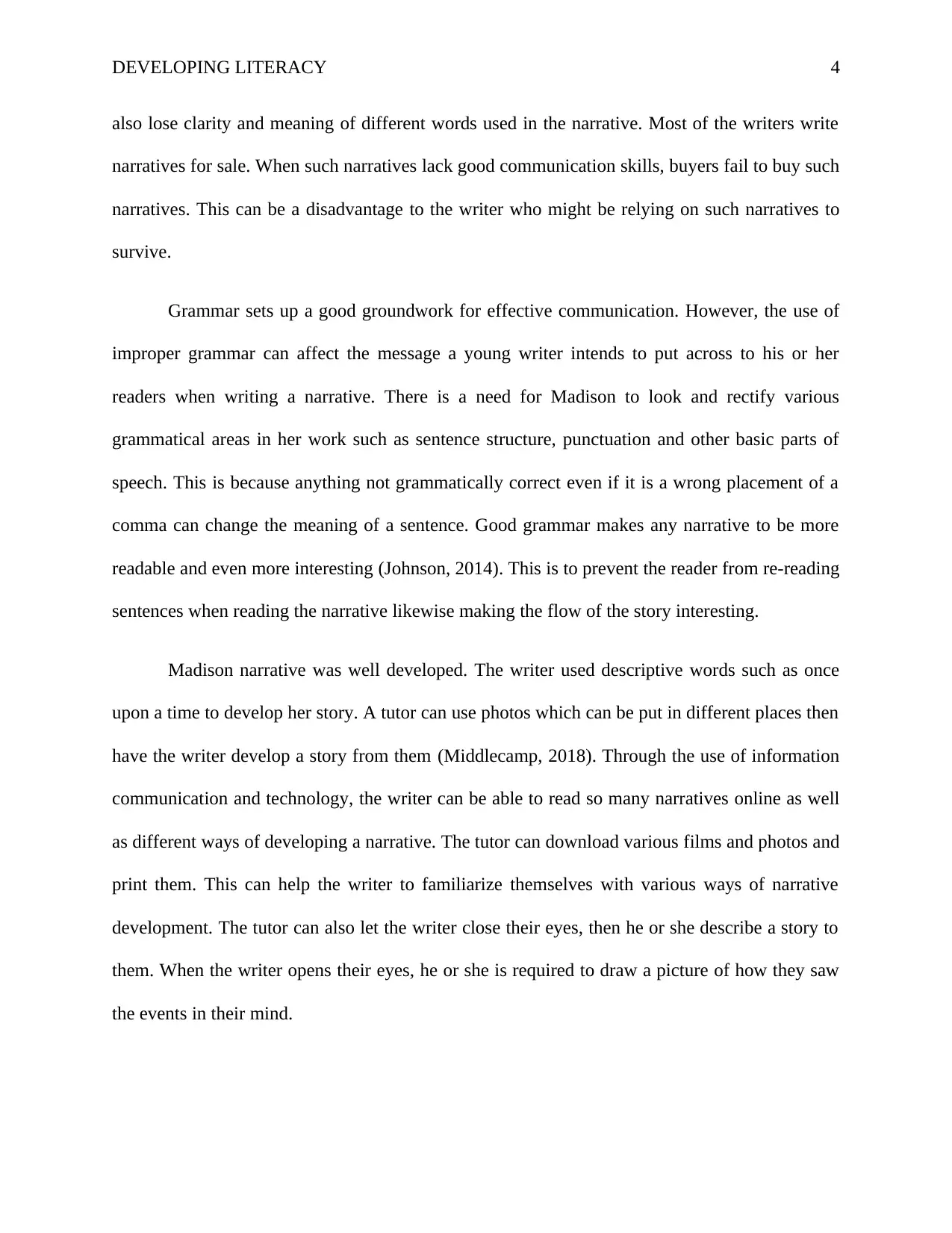
DEVELOPING LITERACY 4
also lose clarity and meaning of different words used in the narrative. Most of the writers write
narratives for sale. When such narratives lack good communication skills, buyers fail to buy such
narratives. This can be a disadvantage to the writer who might be relying on such narratives to
survive.
Grammar sets up a good groundwork for effective communication. However, the use of
improper grammar can affect the message a young writer intends to put across to his or her
readers when writing a narrative. There is a need for Madison to look and rectify various
grammatical areas in her work such as sentence structure, punctuation and other basic parts of
speech. This is because anything not grammatically correct even if it is a wrong placement of a
comma can change the meaning of a sentence. Good grammar makes any narrative to be more
readable and even more interesting (Johnson, 2014). This is to prevent the reader from re-reading
sentences when reading the narrative likewise making the flow of the story interesting.
Madison narrative was well developed. The writer used descriptive words such as once
upon a time to develop her story. A tutor can use photos which can be put in different places then
have the writer develop a story from them (Middlecamp, 2018). Through the use of information
communication and technology, the writer can be able to read so many narratives online as well
as different ways of developing a narrative. The tutor can download various films and photos and
print them. This can help the writer to familiarize themselves with various ways of narrative
development. The tutor can also let the writer close their eyes, then he or she describe a story to
them. When the writer opens their eyes, he or she is required to draw a picture of how they saw
the events in their mind.
also lose clarity and meaning of different words used in the narrative. Most of the writers write
narratives for sale. When such narratives lack good communication skills, buyers fail to buy such
narratives. This can be a disadvantage to the writer who might be relying on such narratives to
survive.
Grammar sets up a good groundwork for effective communication. However, the use of
improper grammar can affect the message a young writer intends to put across to his or her
readers when writing a narrative. There is a need for Madison to look and rectify various
grammatical areas in her work such as sentence structure, punctuation and other basic parts of
speech. This is because anything not grammatically correct even if it is a wrong placement of a
comma can change the meaning of a sentence. Good grammar makes any narrative to be more
readable and even more interesting (Johnson, 2014). This is to prevent the reader from re-reading
sentences when reading the narrative likewise making the flow of the story interesting.
Madison narrative was well developed. The writer used descriptive words such as once
upon a time to develop her story. A tutor can use photos which can be put in different places then
have the writer develop a story from them (Middlecamp, 2018). Through the use of information
communication and technology, the writer can be able to read so many narratives online as well
as different ways of developing a narrative. The tutor can download various films and photos and
print them. This can help the writer to familiarize themselves with various ways of narrative
development. The tutor can also let the writer close their eyes, then he or she describe a story to
them. When the writer opens their eyes, he or she is required to draw a picture of how they saw
the events in their mind.
Paraphrase This Document
Need a fresh take? Get an instant paraphrase of this document with our AI Paraphraser
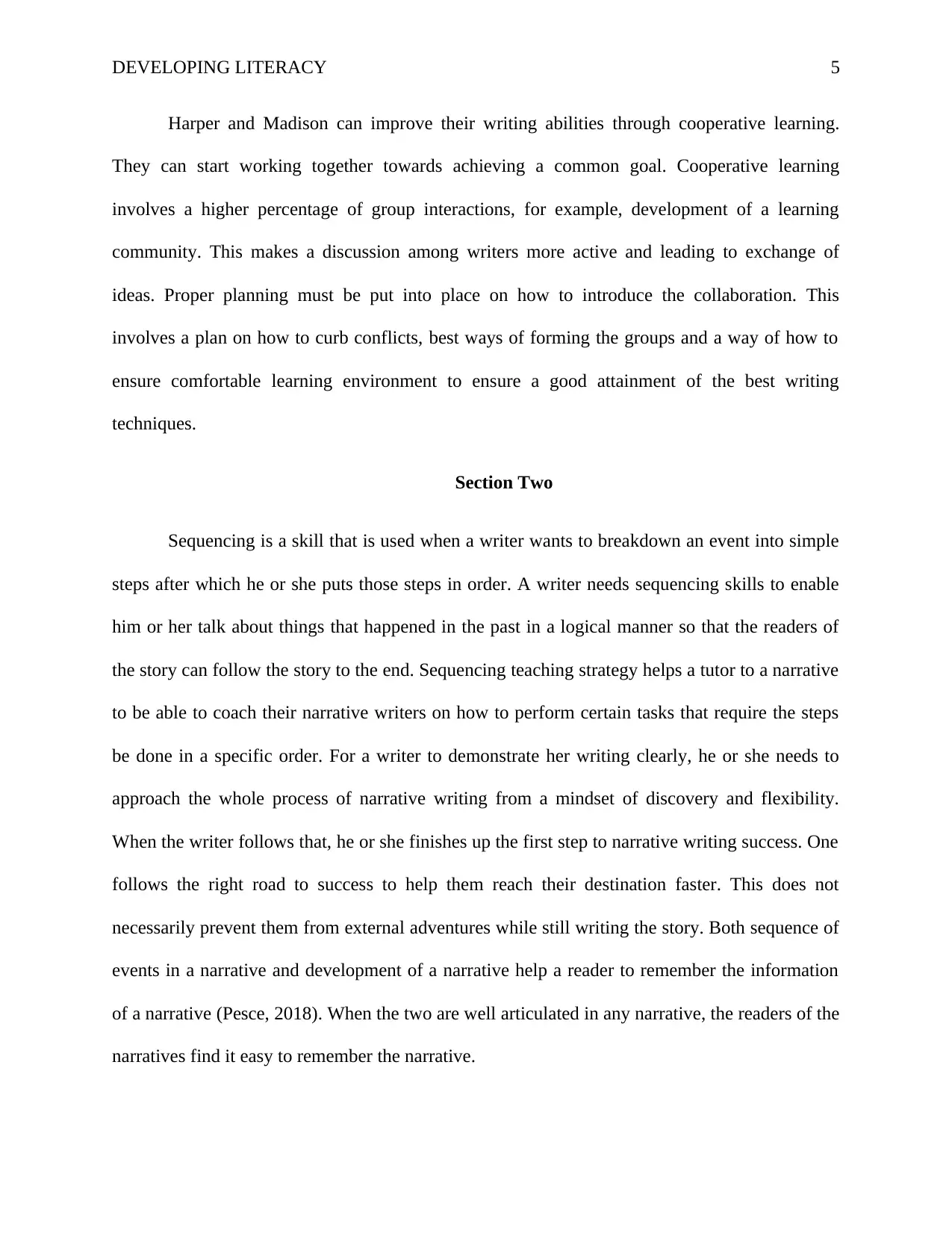
DEVELOPING LITERACY 5
Harper and Madison can improve their writing abilities through cooperative learning.
They can start working together towards achieving a common goal. Cooperative learning
involves a higher percentage of group interactions, for example, development of a learning
community. This makes a discussion among writers more active and leading to exchange of
ideas. Proper planning must be put into place on how to introduce the collaboration. This
involves a plan on how to curb conflicts, best ways of forming the groups and a way of how to
ensure comfortable learning environment to ensure a good attainment of the best writing
techniques.
Section Two
Sequencing is a skill that is used when a writer wants to breakdown an event into simple
steps after which he or she puts those steps in order. A writer needs sequencing skills to enable
him or her talk about things that happened in the past in a logical manner so that the readers of
the story can follow the story to the end. Sequencing teaching strategy helps a tutor to a narrative
to be able to coach their narrative writers on how to perform certain tasks that require the steps
be done in a specific order. For a writer to demonstrate her writing clearly, he or she needs to
approach the whole process of narrative writing from a mindset of discovery and flexibility.
When the writer follows that, he or she finishes up the first step to narrative writing success. One
follows the right road to success to help them reach their destination faster. This does not
necessarily prevent them from external adventures while still writing the story. Both sequence of
events in a narrative and development of a narrative help a reader to remember the information
of a narrative (Pesce, 2018). When the two are well articulated in any narrative, the readers of the
narratives find it easy to remember the narrative.
Harper and Madison can improve their writing abilities through cooperative learning.
They can start working together towards achieving a common goal. Cooperative learning
involves a higher percentage of group interactions, for example, development of a learning
community. This makes a discussion among writers more active and leading to exchange of
ideas. Proper planning must be put into place on how to introduce the collaboration. This
involves a plan on how to curb conflicts, best ways of forming the groups and a way of how to
ensure comfortable learning environment to ensure a good attainment of the best writing
techniques.
Section Two
Sequencing is a skill that is used when a writer wants to breakdown an event into simple
steps after which he or she puts those steps in order. A writer needs sequencing skills to enable
him or her talk about things that happened in the past in a logical manner so that the readers of
the story can follow the story to the end. Sequencing teaching strategy helps a tutor to a narrative
to be able to coach their narrative writers on how to perform certain tasks that require the steps
be done in a specific order. For a writer to demonstrate her writing clearly, he or she needs to
approach the whole process of narrative writing from a mindset of discovery and flexibility.
When the writer follows that, he or she finishes up the first step to narrative writing success. One
follows the right road to success to help them reach their destination faster. This does not
necessarily prevent them from external adventures while still writing the story. Both sequence of
events in a narrative and development of a narrative help a reader to remember the information
of a narrative (Pesce, 2018). When the two are well articulated in any narrative, the readers of the
narratives find it easy to remember the narrative.
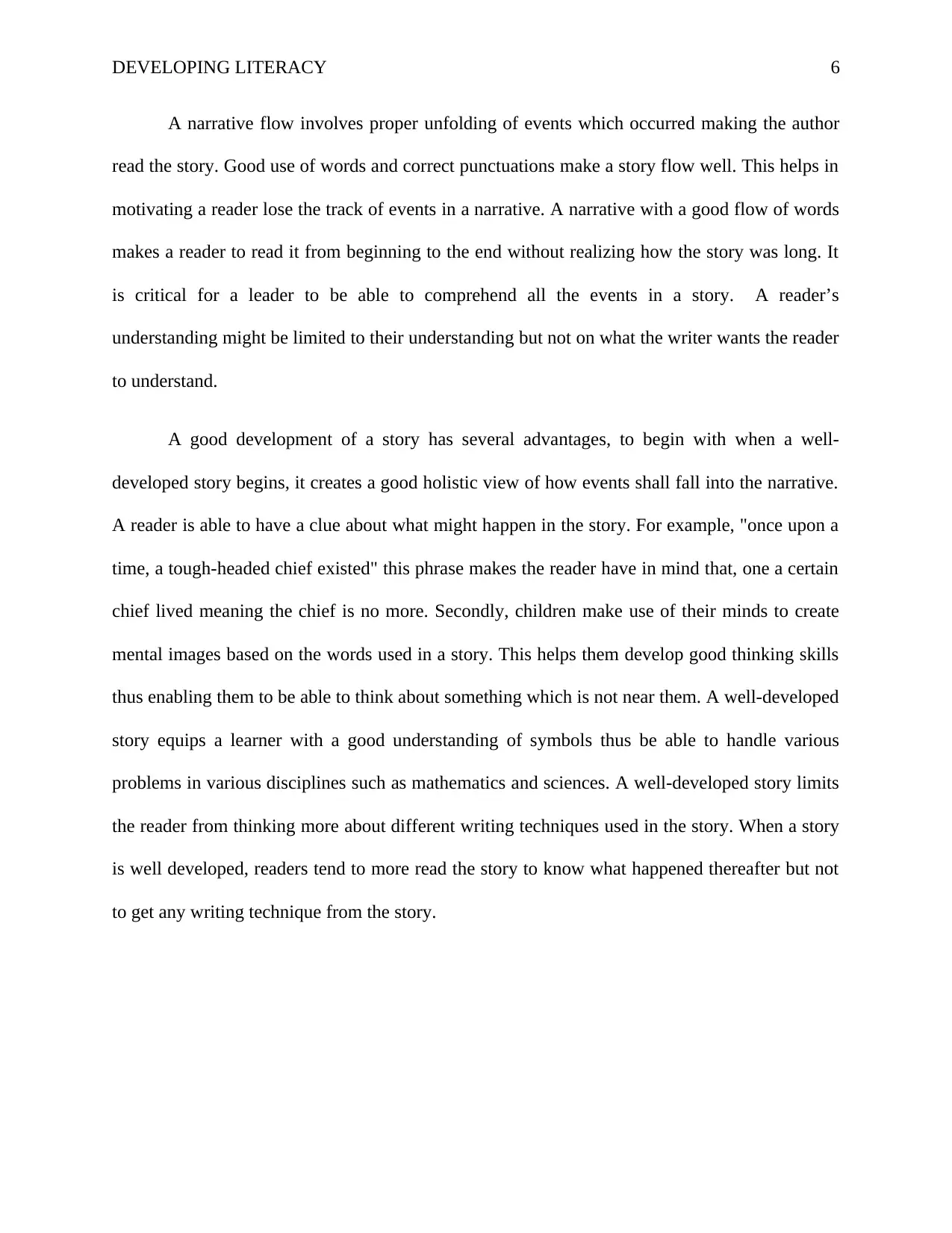
DEVELOPING LITERACY 6
A narrative flow involves proper unfolding of events which occurred making the author
read the story. Good use of words and correct punctuations make a story flow well. This helps in
motivating a reader lose the track of events in a narrative. A narrative with a good flow of words
makes a reader to read it from beginning to the end without realizing how the story was long. It
is critical for a leader to be able to comprehend all the events in a story. A reader’s
understanding might be limited to their understanding but not on what the writer wants the reader
to understand.
A good development of a story has several advantages, to begin with when a well-
developed story begins, it creates a good holistic view of how events shall fall into the narrative.
A reader is able to have a clue about what might happen in the story. For example, "once upon a
time, a tough-headed chief existed" this phrase makes the reader have in mind that, one a certain
chief lived meaning the chief is no more. Secondly, children make use of their minds to create
mental images based on the words used in a story. This helps them develop good thinking skills
thus enabling them to be able to think about something which is not near them. A well-developed
story equips a learner with a good understanding of symbols thus be able to handle various
problems in various disciplines such as mathematics and sciences. A well-developed story limits
the reader from thinking more about different writing techniques used in the story. When a story
is well developed, readers tend to more read the story to know what happened thereafter but not
to get any writing technique from the story.
A narrative flow involves proper unfolding of events which occurred making the author
read the story. Good use of words and correct punctuations make a story flow well. This helps in
motivating a reader lose the track of events in a narrative. A narrative with a good flow of words
makes a reader to read it from beginning to the end without realizing how the story was long. It
is critical for a leader to be able to comprehend all the events in a story. A reader’s
understanding might be limited to their understanding but not on what the writer wants the reader
to understand.
A good development of a story has several advantages, to begin with when a well-
developed story begins, it creates a good holistic view of how events shall fall into the narrative.
A reader is able to have a clue about what might happen in the story. For example, "once upon a
time, a tough-headed chief existed" this phrase makes the reader have in mind that, one a certain
chief lived meaning the chief is no more. Secondly, children make use of their minds to create
mental images based on the words used in a story. This helps them develop good thinking skills
thus enabling them to be able to think about something which is not near them. A well-developed
story equips a learner with a good understanding of symbols thus be able to handle various
problems in various disciplines such as mathematics and sciences. A well-developed story limits
the reader from thinking more about different writing techniques used in the story. When a story
is well developed, readers tend to more read the story to know what happened thereafter but not
to get any writing technique from the story.
⊘ This is a preview!⊘
Do you want full access?
Subscribe today to unlock all pages.

Trusted by 1+ million students worldwide
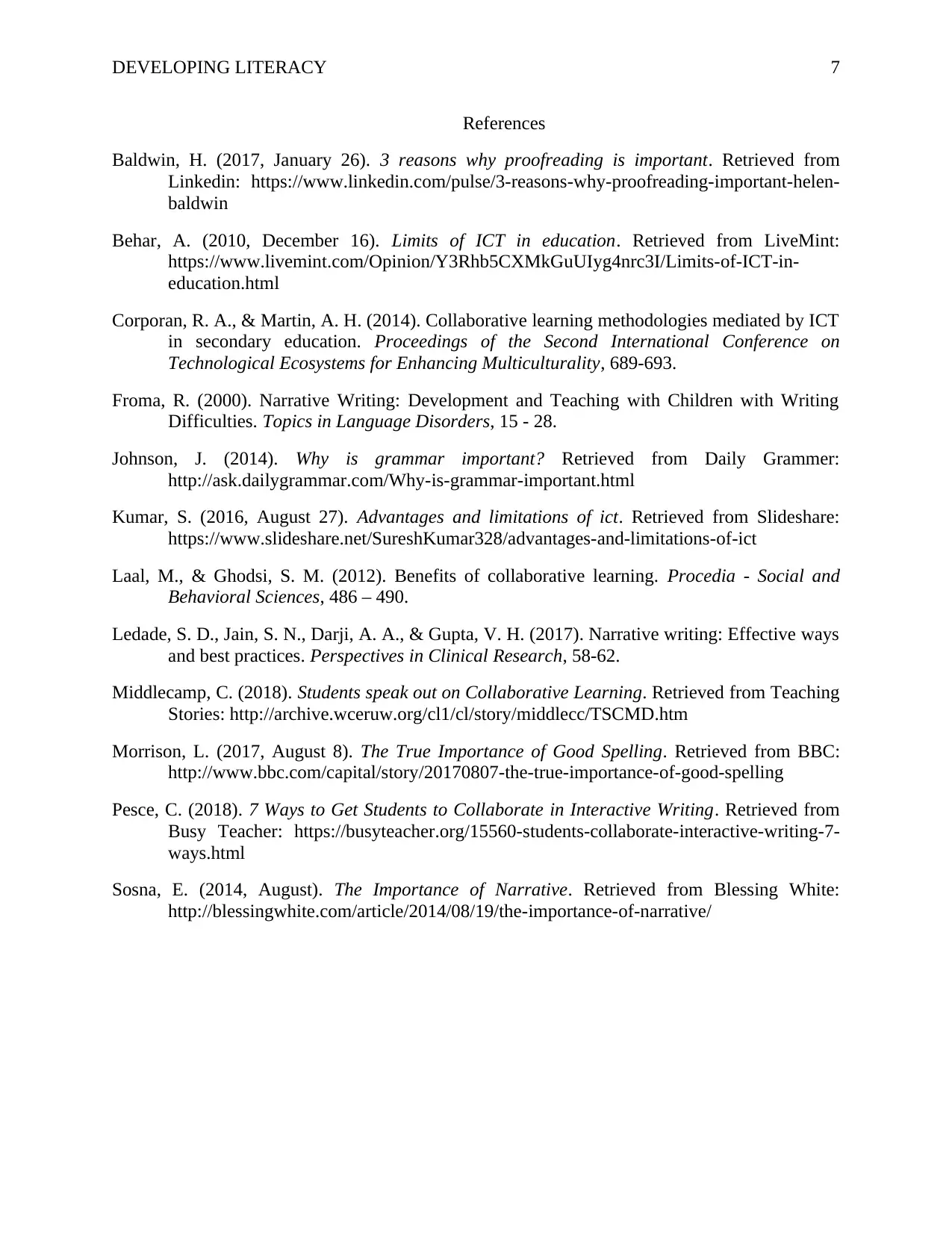
DEVELOPING LITERACY 7
References
Baldwin, H. (2017, January 26). 3 reasons why proofreading is important. Retrieved from
Linkedin: https://www.linkedin.com/pulse/3-reasons-why-proofreading-important-helen-
baldwin
Behar, A. (2010, December 16). Limits of ICT in education. Retrieved from LiveMint:
https://www.livemint.com/Opinion/Y3Rhb5CXMkGuUIyg4nrc3I/Limits-of-ICT-in-
education.html
Corporan, R. A., & Martin, A. H. (2014). Collaborative learning methodologies mediated by ICT
in secondary education. Proceedings of the Second International Conference on
Technological Ecosystems for Enhancing Multiculturality, 689-693.
Froma, R. (2000). Narrative Writing: Development and Teaching with Children with Writing
Difficulties. Topics in Language Disorders, 15 - 28.
Johnson, J. (2014). Why is grammar important? Retrieved from Daily Grammer:
http://ask.dailygrammar.com/Why-is-grammar-important.html
Kumar, S. (2016, August 27). Advantages and limitations of ict. Retrieved from Slideshare:
https://www.slideshare.net/SureshKumar328/advantages-and-limitations-of-ict
Laal, M., & Ghodsi, S. M. (2012). Benefits of collaborative learning. Procedia - Social and
Behavioral Sciences, 486 – 490.
Ledade, S. D., Jain, S. N., Darji, A. A., & Gupta, V. H. (2017). Narrative writing: Effective ways
and best practices. Perspectives in Clinical Research, 58-62.
Middlecamp, C. (2018). Students speak out on Collaborative Learning. Retrieved from Teaching
Stories: http://archive.wceruw.org/cl1/cl/story/middlecc/TSCMD.htm
Morrison, L. (2017, August 8). The True Importance of Good Spelling. Retrieved from BBC:
http://www.bbc.com/capital/story/20170807-the-true-importance-of-good-spelling
Pesce, C. (2018). 7 Ways to Get Students to Collaborate in Interactive Writing. Retrieved from
Busy Teacher: https://busyteacher.org/15560-students-collaborate-interactive-writing-7-
ways.html
Sosna, E. (2014, August). The Importance of Narrative. Retrieved from Blessing White:
http://blessingwhite.com/article/2014/08/19/the-importance-of-narrative/
References
Baldwin, H. (2017, January 26). 3 reasons why proofreading is important. Retrieved from
Linkedin: https://www.linkedin.com/pulse/3-reasons-why-proofreading-important-helen-
baldwin
Behar, A. (2010, December 16). Limits of ICT in education. Retrieved from LiveMint:
https://www.livemint.com/Opinion/Y3Rhb5CXMkGuUIyg4nrc3I/Limits-of-ICT-in-
education.html
Corporan, R. A., & Martin, A. H. (2014). Collaborative learning methodologies mediated by ICT
in secondary education. Proceedings of the Second International Conference on
Technological Ecosystems for Enhancing Multiculturality, 689-693.
Froma, R. (2000). Narrative Writing: Development and Teaching with Children with Writing
Difficulties. Topics in Language Disorders, 15 - 28.
Johnson, J. (2014). Why is grammar important? Retrieved from Daily Grammer:
http://ask.dailygrammar.com/Why-is-grammar-important.html
Kumar, S. (2016, August 27). Advantages and limitations of ict. Retrieved from Slideshare:
https://www.slideshare.net/SureshKumar328/advantages-and-limitations-of-ict
Laal, M., & Ghodsi, S. M. (2012). Benefits of collaborative learning. Procedia - Social and
Behavioral Sciences, 486 – 490.
Ledade, S. D., Jain, S. N., Darji, A. A., & Gupta, V. H. (2017). Narrative writing: Effective ways
and best practices. Perspectives in Clinical Research, 58-62.
Middlecamp, C. (2018). Students speak out on Collaborative Learning. Retrieved from Teaching
Stories: http://archive.wceruw.org/cl1/cl/story/middlecc/TSCMD.htm
Morrison, L. (2017, August 8). The True Importance of Good Spelling. Retrieved from BBC:
http://www.bbc.com/capital/story/20170807-the-true-importance-of-good-spelling
Pesce, C. (2018). 7 Ways to Get Students to Collaborate in Interactive Writing. Retrieved from
Busy Teacher: https://busyteacher.org/15560-students-collaborate-interactive-writing-7-
ways.html
Sosna, E. (2014, August). The Importance of Narrative. Retrieved from Blessing White:
http://blessingwhite.com/article/2014/08/19/the-importance-of-narrative/
1 out of 7
Related Documents
Your All-in-One AI-Powered Toolkit for Academic Success.
+13062052269
info@desklib.com
Available 24*7 on WhatsApp / Email
![[object Object]](/_next/static/media/star-bottom.7253800d.svg)
Unlock your academic potential
Copyright © 2020–2025 A2Z Services. All Rights Reserved. Developed and managed by ZUCOL.
